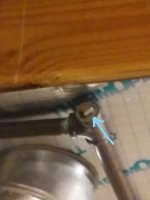logwolf
New Member
Hello everyone
Hope someone can answer this.
I'm installing a new gas water heater . I'm replacing the current electric water heater.
The location of the new heater will be a new location, more equidistant between the two bathrooms in the house. It will be located in a full basement, 50 x 27 feet(1350 SF).
There is a 3/4" gas line coming in from the meter. That line runs apprc 10 feet into the basement behind the gas furnace. The 3/4" line stops at a 3/4" T. This T is capped on one outlet of it. The tail section of the T has another 3/4" pipe running approx. 3-4 feet toward furnace where a 1/2" to 3/4" elbow is located. At the 1/2" end of this elbow, runs a pipe leading down to the furnace.
This is currently, the only gas appliance in the house.
The amount of black pipe I will need to run from the T to the new water heater , is approx. 40 linear feet.
My question is...Do I need to run 3/4" pipe to the area above the heater, then use 1/2" pipe for the vertical run down to heater area? OR Can I reduce the T connection down to 1/2" and run 1/2" all the way(40 ft), to new heater? Photo shows T fitting with plug.
Hope someone can answer this.
I'm installing a new gas water heater . I'm replacing the current electric water heater.
The location of the new heater will be a new location, more equidistant between the two bathrooms in the house. It will be located in a full basement, 50 x 27 feet(1350 SF).
There is a 3/4" gas line coming in from the meter. That line runs apprc 10 feet into the basement behind the gas furnace. The 3/4" line stops at a 3/4" T. This T is capped on one outlet of it. The tail section of the T has another 3/4" pipe running approx. 3-4 feet toward furnace where a 1/2" to 3/4" elbow is located. At the 1/2" end of this elbow, runs a pipe leading down to the furnace.
This is currently, the only gas appliance in the house.
The amount of black pipe I will need to run from the T to the new water heater , is approx. 40 linear feet.
My question is...Do I need to run 3/4" pipe to the area above the heater, then use 1/2" pipe for the vertical run down to heater area? OR Can I reduce the T connection down to 1/2" and run 1/2" all the way(40 ft), to new heater? Photo shows T fitting with plug.

